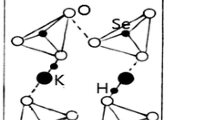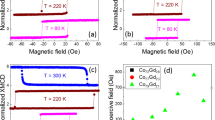Abstract
The relaxation of nuclear magnetization in the 29Si:B crystals obeys power-law kinetics at 300 K due to direct electron–nuclear relaxation. Admixture of the exponential relaxation associated with spin diffusion was revealed at higher temperatures. The inhomogeneous distribution of linear deformation defects was revealed by electron paramagnetic resonance. This factor mainly contributes to power-law kinetics of nuclear spin relaxation.




Similar content being viewed by others
References
Hui HT (2006) Numerical method for determination of the NMR frequency of the single-qubit operation in a silicon-based solid-state quantum computer. Phys Rev B 74:195309
Zwanenburg FA, Dzurak AS, Morello A, Simmons MY, Hollenberg LCL, Klimeck G, Rogge S, Coppersmith SN, Eriksson MA (2013) Silicon quantum electronics. Rev Mod Phys 85:961–1019
Shlimak I, Safarov VI, Vagner ID (2001) Isotopically engineered silicon/silicon-germanium nanostructures as basic elements for a nuclear spin quantum computer. J Phys 13:6059
Itoh KM (2005) An all-silicon linear chain NMR quantum computer. Solid State Commun 133:747
Kane BE (1998) A silicon-based nuclear spin quantum computer. Nature 393:133–137
Simmons S, Brown RM, Riemann H, Abrosimov NV, Becker P, Pohl H, Thewalt MLW, Itoh KM, Morton JJL (2011) Entanglement in a solid-state spin ensemble. Nature 470:69–72
Stegner AR, Tezuka H, Riemann H, Abrosimov NV, Becker P, Pohl HJ, Thewalt MLW, Itoh KM, Brandt MS (2011) Correlation of residual impurity concentration and acceptor electron paramagnetic resonance linewidth in isotopically engineered Si. Appl Phys Lett 99:032101
Hayashi H, Itoh KM, Vlasenko LS (2008) Nuclear magnetic resonance linewidth and spin diffusion in 29Si isotopically controlled silicon. Phys Rev B 78:153201
Hayashi H, Itahashi T, Itoh KM, Vlasenko LS, Vlasenko MP (2009) Nuclear magnetic resonance linewidth and spin diffusion in 29Si isotopically controlled silicon. Phys Rev B 80:045201
Fuller SE, Meintjes EM, Warren WW (1996) Impurity NMR study of the acceptor band in Si(B). Phys Rev Lett 76:2806
Sundfors RK, Holcomb DF (1964) Nuclear magnetic resonance studies of the metallic transition in doped silicon. Phys Rev 136:A810–A820
Neubrand H (1978) ESR from boron in silicon at zero and small external stress I. Line positions and line structure. Phys Status Solidi (b) 86:269–275
Bartelsen L (1977) The EPR fine structure spectrum of dislocations in silicon. Phys Status Solidi (b) 81:471–478
Stegner AR, Tezuka H, Andlauer T, Stutzmann M, Thewalt MLW, Brandt MS, Itoh KM (2010) Isotope effect on electron paramagnetic resonance of boron acceptors in silicon. Phys Rev B 82:115213
Tezuka H, Stegner AR, Tyryshkin AM, Shankar S, Thewalt MLW, Lyon SA, Itoh KM, Brandt MS (2010) Isotope effect on electron paramagnetic resonance of boron acceptors in silicon. Phys Rev B 81:161203(R)
Bagraev NT, Gusarov AI, Mashkov VA (1987) Spin-dependent processes in one-dimensional disordered dangling-bond systems in semiconductors. J Exp Theor Phys 92:548–549
Grazhulis VA, Ossipyan YuA (1971) Electron paramagnetic resonance of dislocations in silicon. J Exp Theor Phys 60:623–628
Weber ER, Alexander H (1983) Deep level defects in plastically deformed silicon. J Phys 44:C4-319–C4-328
Bagraev NT, Vlasenko LS (1982) Optical polarization of lattice nuclei in plastically deformed silicon. J Exp Theor Phys 83:1267–1274
Edèn M (2012) NMR studies of oxide-based glasses. Annu Rep Prog Chem Sect C 108:177–221
Verhulst AS, Maryenko D, Yamamoto Y, Itoh KM (2003) Double and single peaks in nuclear magnetic resonance spectra of natural and 29Si—enriched single-crystal silicon. Phys Rev B 68:054105
Devreux F, Boilot JP, Chaput F, Sapoval B (1990) NMR determination of the fractal dimension in silica aerogels. Phys Rev Lett 65:614
Sen S, Stebbins JF (1994) Phase separation, clustering, and fractal characteristics in glass: a magic-angle-spinning NMR spin-lattice relaxation study. Phys Rev B 50:822
Blumberg WE (1960) Nuclear spin-lattice relaxation caused by paramagnetic impurities. Phys Rev 119:79
Le Guennec P, Nechtschein M, Travers JP (1993) Nonexponential NMR relaxations in heterogeneously doped solids. Phys Rev B 47:2893
Feher G, Hensel JC, Gere EA (1960) Paramagnetic resonance absorption from acceptors in silicon. Phys Rev Lett 5:309
Skvortsov AA, Orlov AM, Gonchar LI (2001) The effect of a weak magnetic field on the mobility of dislocations in silicon. J Exp Theor Phys 93:117 (Rus. Translated from Zhurnal Éksperimental’noi Teoretichesko Fiziki, 120(1):134–138, 2001)
Yonenaga I, Takahashi K (2006) Effect of high-magnetic-field on dislocation-oxygen impurity interaction in Si. J Phys 51:407
Acknowledgements
O.V.K. (Project 14-03-31004) and R.B.M. (Project 13-07-12027) thank Russian Foundation for Basic Researches for the financial support.
Author information
Authors and Affiliations
Corresponding author
Rights and permissions
About this article
Cite this article
Morgunov, R.B., Koplak, O.V. High-temperature spin dynamics studied by solid-state nuclear resonance and electron paramagnetic resonance in 29Si:B crystals. J Mater Sci 51, 1838–1844 (2016). https://doi.org/10.1007/s10853-015-9490-2
Received:
Accepted:
Published:
Issue Date:
DOI: https://doi.org/10.1007/s10853-015-9490-2




